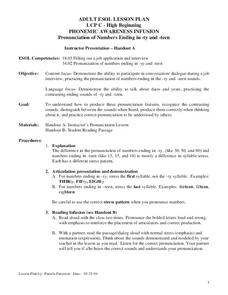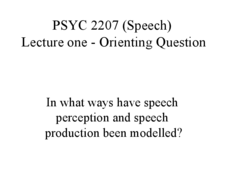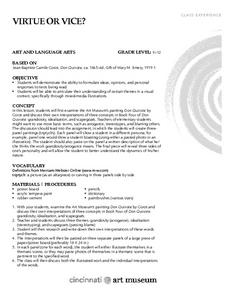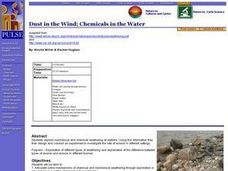Curated OER
PHONEMIC AWARENESS INFUSION
Students demonstrate the ability to participate in conversation/ dialog during a job interview. They demonstrate how to produce these pronunciation features, recognize the contrasting sounds, distinguish between the sounds when heard,...
Curated OER
Facial Symmetry
Learners study facial symmetry. They explore lines of symmetry, and create illustrations with multiple lines of symmetry.
Curated OER
Night: Socratic Questioning Activity
We construct meaning through discussion, so help your readers of Elie Wiesel's work Night with a socratic questioning activity. The strategy is outlined on the first page, and the second page offers some example questions you give to...
Arizona State University
Roundup Shapes
Let's study 2-D shapes! Young mathematicians compare and classify shapes according to attributes. They evaluate shape riddles and predict the shape being described. Here is the website where you can find the lesson...
Curated OER
PSYC 2207 (Speech): Lecture One
A great way to introduce a speech pathology or psychology class, this lecture takes students through various theories on speech perception and speech production. Students will find the information applicable and easy to digest, and...
Curated OER
Virtue Or Vice?
Students create triptychs, pictures in three panels side by side, of certain themes displayed in the painting "Don Quixote" by Jean-Baptiste Camile Carot. Student evaluations are accomplished through participation during in-class...
Curated OER
In Katrina's Wake
You will need to go to the National Center for Biotechnology Information website to obtain the article, "In Katrina's Wake." Have your class read it and examine maps of where toxic chemicals were located in Louisiana at the time,...
Curated OER
Hypatia: Angles
Introduce your young geometers to Hypatia, the first noted Greek female mathematician, and the properties of angles. Though this resource is missing worksheets that are needed to complete the lesson, the structure is sound and learning...
Curated OER
CDs: Creating Direction
Students articulate a direction about prejudice through text and images via a CD album cover. In this prejudice lesson, students view images for prejudice from various sources. Students brainstorm words that contribute to the meaning of...
Curated OER
Dust in the Wind; Chemicals in the Water
Students explore mechanical and chemical weathering at stations. They articulate some mechanisms of chemical and mechanical weathering through exploration in a lab. Students stations describe how chemical weathering differs from...
Curated OER
Is That a Fact?
Students write examples of facts and opinions on the board. In groups, they develop their own definitions for facts and opinions and share with the class. In new groups, they complete a worksheet in which they place statements into the...
Curated OER
Restorative Justice
Sixth graders study restorative justice. In this government instructional activity, 6th graders discuss restorative justice, examine the ways restitution can be made when a crime occurs, and write about a conflict at home or school and...
Curated OER
Salon Simulation
Learners examine the role of the 'Salon'. For this historic communications lesson, students role play and use discussion to enhance their understanding of the role the Salon played in 18th century Europe. Learners will divide into...
Curated OER
Reading Fiction: Analyzing Sentences
Students investigate sentence construction in fiction. In this sentence construction lesson, students examine examples of fiction work and discover why sentences are a certain length. Students create their own passages...
Curated OER
Delivering a Persuasive Speech
To prepare to deliver a persuasive speech, class members examine not only how to craft a speech, but consider body language, articulation, pronunciation, pitch, pace, and volume as well.
Curated OER
Parallel and Perpendicular Lines
Learners study parallel and perpendicular lines. In this parallel and perpendicular lesson, pupils explore 2-D shapes and determine if the sides are parallel or perpendicular.
Curated OER
Phonemic Awareness Infusion
Students explore and describe various kinds of work experiences and skills practicing the regular past tense -ed sounds. They practice pronouncing those sounds with verbs within their reading passages as well. In addition, they repeat...
Mathematics Vision Project
Module 6: Congruence, Construction, and Proof
Trace the links between a variety of math concepts in this far-reaching unit. Ideas that seem very different on the outset (like the distance formula and rigid transformations) come together in very natural and logical ways. This...
EngageNY
Making Fair Decisions
Life's not fair, but decisions can be. The 17th installment of a 21-part module teaches learners about fair decisions. They use simulations to develop strategies to make fair decisions.
EngageNY
Base Angles of Isosceles Triangles
Build confidence in proofs by proving a known property. Pupils explore two approaches to proving base angles of isosceles triangles are congruent: transformations and SAS. They then apply their understanding of the proof to more complex...
Smithsonian Institution
Water/Ways: The Poetry of Science
Water is the source of life. It appears in poetry in both peaceful and torrential descriptions; it appears in earth science in its liquid, gaseous, and solid states. Combine these interpretations of our planet's most precious and...
Teach Engineering
Magical Motion
Make solutions to projectile motion problems magically appear using equations. Pupils watch a clip from a Harry Potter movie and find the length of time it takes for a remembrall to fall into Harry's hands. They use a projectile motion...
National Endowment for the Humanities
Lesson 3: Britain, Napoleon, and the American Embargo, 1803–1808
While the French were once the allies of Americans, the Napoleonic Wars saw the United States almost drawn into a war with its one-time friend. Wars in Europe threatened to draw in the early republic. A primary source-based activity...
Howard Hughes Medical Institute
Niche Partitioning Activity
Dinnertime on the African savanna is a highly choreographed event! Introduce young ecologists to the concept of niche partitioning through a hands-on activity. Pupils research animal behaviors and use data to develop an understanding of...























